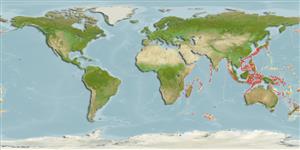Environment: milieu / climate zone / depth range / distribution range
Écologie
marin bathydémersal; profondeur 344 - 549 m (Ref. 26165). Deep-water
Indo-Pacific: Arabian and Andaman seas, Bay of Bengal, Japan, and the Philippines.
Taille / Poids / Âge
Maturity: Lm ? range ? - ? cm
Max length : 9.0 cm SL mâle / non sexé; (Ref. 559)
Description synthétique
Morphologie | Morphométrie
This species is without a distinct pattern on the body, but with an intensely pigmented region of nostrils and distal ends of the fins in preserved specimens, with a pigmented peritoneum; well-developed bucklers on the dorsal and ventral surfaces of the disc, forming an M-shaped row on the dorsal surface, not homogeneous in size on the ventral one, larger in front of the bases of V; high pointed tops of bucklers along the edge of the disc and in the caudal region; acicular spines with wide bases and 1-2 tops (as an exception, 3); a bisinuate upper edge of the illicial cavity, clearly protruding forward in lateral view; a long subopercular spine directed laterally and distinctly backward; long (47.0-50.9% SL) caudal section of the body; moderately large eye (7.6-8.5% SL), and a narrow interorbital gap (4.9-5.7% SL); D no rays (Ref. 123832).
Minimum depth from Ref. 58018.
Life cycle and mating behavior
Maturité | Reproduction | Frai | Œufs | Fécondité | Larves
Prokofiev, A.M., 2020. A new species of batfish of the genus Halicmetus from Vietnam and new norphological data for H. ruber (Ogcocephalidae). J. Ichthyol. 60(6):828-838. (Ref. 123832)
Statut dans la liste rouge de l'IUCN (Ref. 130435)
Menace pour l'homme
Harmless
Utilisations par l'homme
Pêcheries: sans intérêt
Plus d'informations
Noms communsSynonymesMétabolismePrédateursÉcotoxicologieReproductionMaturitéFraiRassemblement de ponteFéconditéŒufsDéveloppement de l'œuf
Taille/ÂgeCroissanceLongueur-poidsLongueur-longueurFréquences de longueursMorphométrieMorphologieLarvesDynamique des populations larvairesRecrutementAbondanceBRUVS
RéférencesAquacultureProfil d'aquacultureSouchesGénétiqueElectrophoresesHéritabilitéPathologiesTraitementNutrientsMass conversion
CollaborateursImagesStamps, Coins Misc.SonsCiguateraVitesseType de nageSurface branchialeOtolithesCerveauxVision
Outils
Articles particuliers
Télécharger en XML
Sources Internet
Estimates based on models
Preferred temperature (Ref.
123201): 6.4 - 13.7, mean 10.2 °C (based on 182 cells).
Phylogenetic diversity index (Ref.
82804): PD
50 = 0.6250 [Uniqueness, from 0.5 = low to 2.0 = high].
Bayesian length-weight: a=0.01479 (0.00517 - 0.04233), b=2.93 (2.69 - 3.18), in cm total length, based on LWR estimates for this (Sub)family-body shape (Ref.
93245).
Niveau trophique (Ref.
69278): 3.3 ±0.5 se; based on size and trophs of closest relatives
Résilience (Ref.
120179): Milieu, temps minimum de doublement de population : 1,4 à 4,4 années (Preliminary K or Fecundity.).
Fishing Vulnerability (Ref.
59153): Low vulnerability (10 of 100).
